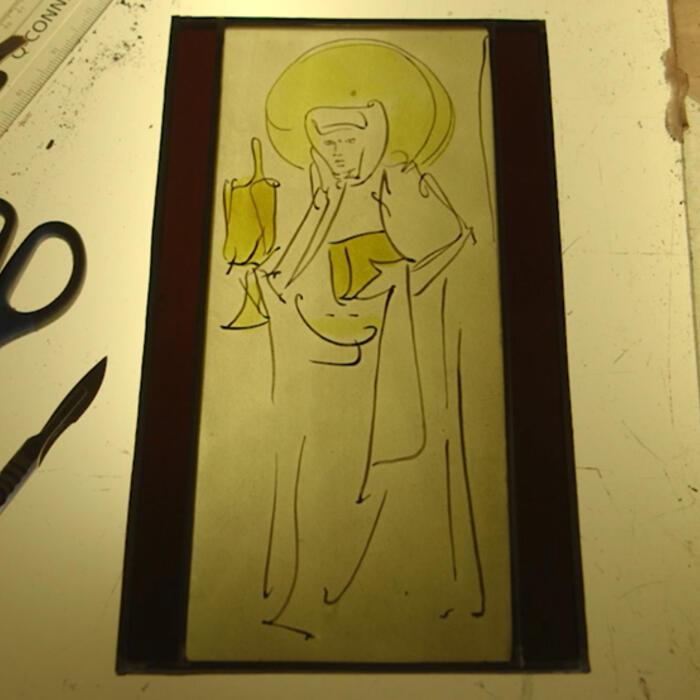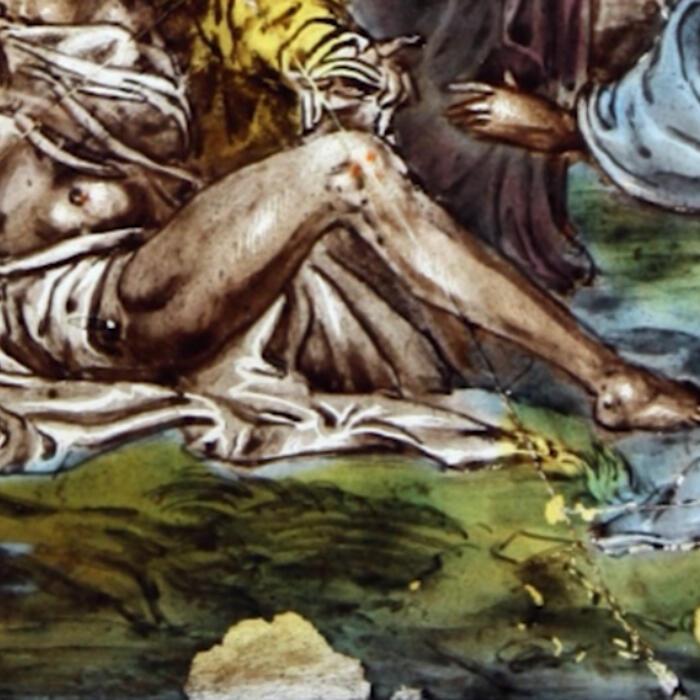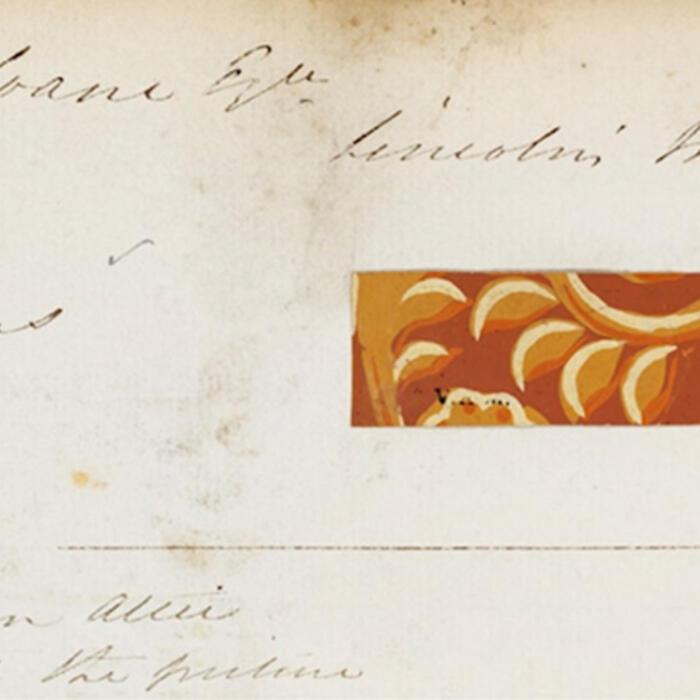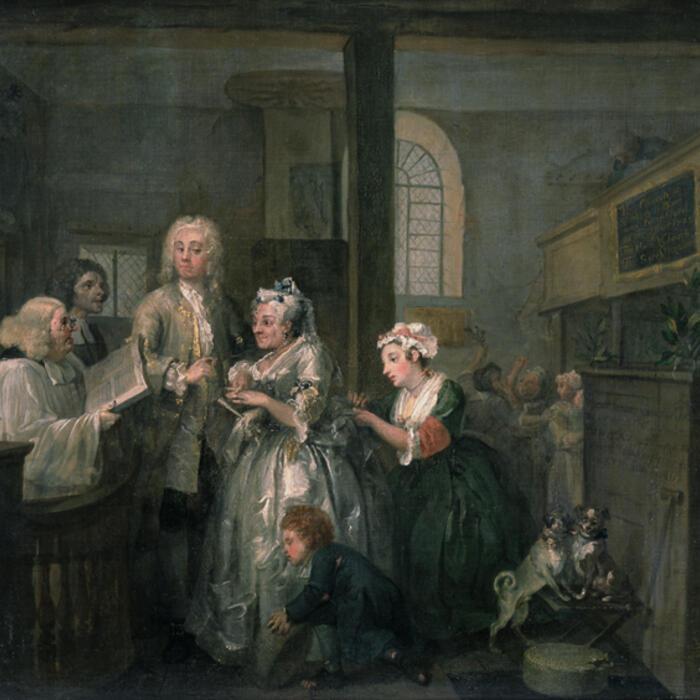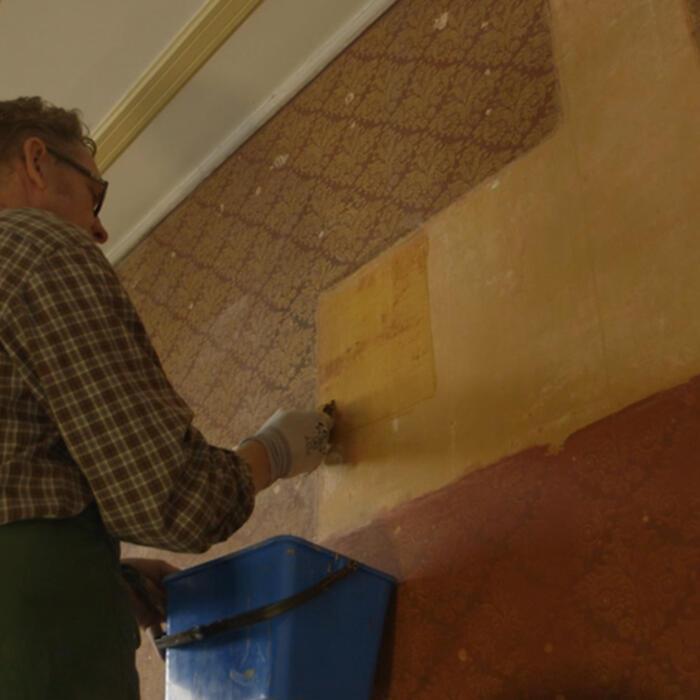Search results
Missing panels Back to top
Rachel also recreated two further panels, for which there were no originals to work from, by copying the watercolour record drawing of them in Soane’s inventory diagram – which is the only detailed evidence of their appearance that survives. The film shows her work on the figure thought to be St Clare. The finished effect is of a kind of ‘ghost’ panel – a shadow of its original self but the most honest way of including what we know of it in the recreated window.
Restoring existing panels Back to top
Chapel studio also restored the surviving panels of 16th and 17th century glass for this window and the film shows the painstaking work required where a distinctive green colour has been lost from the lower edge of a panel of the Raising of Lazarus painted in enamel colours over yellow stain. The enamel paint has gone but the yellow stain is still present.
In order to avoid adding modern paint to the original panel a glass backplate is placed behind it, on which a small patch of blue enamel has been painted in the correct consistency in precisely the right position. When the two panes are sandwiched together, the lost colour is restored as blue and yellow combine to reproduce the missing green.
Rachel and her colleagues at Chapel studio are among a small number of specialists in Britain capable of reproducing and restoring historic stained and painted glass so beautifully. Find out more about Chapel Studio at www.chapelstudio.co.uk.
4. The Arrest Back to top
Tom has squandered his fortune. On the way to the Queen’s birthday reception at St James’ Palace, he narrowly escapes arrest for debt. He is saved by the loyal Sarah Young, now a milliner, who pays his bail money with her meagre earnings.
It is Queen Caroline's birthday – also St David's Day (1st March) – the two bailiffs wear leeks in their hats to mark the occasion.
A street urchin steals Tom's gold-topped cane, while a lamplighter, distracted by the commotion, accidentally pours oil on Tom's wig.
Researching the original wallpaper Back to top
A number of bills in the Soane Museum’s rich archive prove that the second floor of 13 Lincoln’s Inn Fields, where Soane had his bedroom, bathroom and Model Room, was wallpapered throughout in the same paper, made by Cowtan.
At the start of the Opening up the Soane project we had just one tiny piece of physical evidence – a small sample of Soane’s wallpaper pasted into the Cowtan Order Book in the Victoria and Albert Museum. Whilst this provided precise evidence of the original bright colours it didn't show enough of the pattern to reproduce the paper.
The first priority on site, as soon as the area was vacant, had to be to search for any surviving fragments of Soane’s wallpaper beneath many layers of later paint and paper on the second floor itself.
Choosing where to search Back to top
To do this Julian Harrap Architects turned to Mark Sandiford, a leading specialist in the conservation of historic wallpaper, well-versed in this kind of search. He began in the recently vacated back office, around the chimneybreast in what was originally Soane’s Bath Room.
In Mark’s experience, decorators often don’t fully strip fireplace walls because it’s more complicated to do, and so fragments of older wallpapers can commonly be found to survive in those areas. Initially, the walls looked extremely unpromising, covered in a modern anaglypta paper and painted yellow, the most recent of many re-decorations since Soane’s time. However, after a few hours work Mark was able to report that there was at least one large surviving area of paper.
5. The Marriage Back to top
Impoverished, but accustomed to a life of luxury and excess, Tom marries an old woman for her fortune. The shabby setting is Marylebone church, then a well-known venue for clandestine weddings on the northern fringes of London.
Tom is clearly more interested in the pretty young maid than in his one-eyed bride. Two dogs (one of which has also lost an eye) present a grotesque parody of the marriage.
Behind them, Sarah Young and her mother are being held back at the church door.
Chapter 1 Back to top
Morbi lectus ligula, tempor ac euismod sit amet, vehicula et justo. Curabitur rutrum sodales felis sed faucibus. Nunc condimentum malesuada magna. Vivamus diam lorem, faucibus sodales elementum sed, vehicula eget quam. Integer eget molestie turpis, eu laoreet sem.
Stripping to the original wallpaper Back to top
The stripping process undertaken to uncover the early 19th century paper is highly skilled and requires the utmost attention. As Mark says, it is ‘potentially boring’ but requires you to ‘maintain total concentration’ or risk damage to the delicate paper you are trying to uncover.
Using paint stripping chemicals the upper layers of paint and modern paper are removed. Then chemicals are applied to soften the remaining over-paint and a sharpened continental filling knife used to remove it – a painstaking process that involves sliding the tool gently across the surface without applying pressure so as to avoid causing damage.
The last remnants of paint on the surface of the original paper are then removed with extreme care using a medium-to-fine wire wool. This sounds drastic but Mark has found that it is the most effective method. The most important aspect of this final stage of work is to avoid damaging the surface of the original paper by ‘working’ it too much. Using a softer material, such as cotton wool, requires more pressure and more work and therefore causes more damage.
The results Back to top
Mark Sandiford’s work revealed surviving wallpaper on almost the entire east wall of the Bath Room. This provided all the evidence required to recreate the repeat pattern and enabled us to commission reproduction wallpaper which precisely replicates the original paper hung by John Soane in the early 19th century.
6. The Gaming House Back to top
We are in White's Club, in Soho. Tom, wigless and cursing his fate, has just gambled away his second fortune.
He’s not the only loser here – a dejected highwayman (with pistol and mask protruding from his pocket) sits by the fire, and a nobleman, eager to continue playing, pleads with a moneylender for an advance.
Only two croupiers have noticed the smoke curling in from behind the panelling. Everyone else gambles on, unaware of the impending danger.

